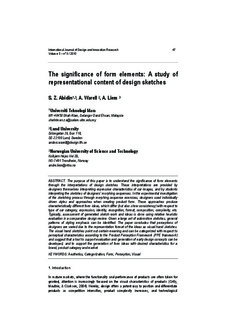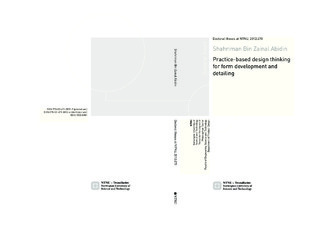| dc.contributor.advisor | Liem, Andre | nb_NO |
| dc.contributor.advisor | Warell, Anders | nb_NO |
| dc.contributor.author | Abidin, Shahriman Bin Zainal | nb_NO |
| dc.date.accessioned | 2014-12-19T12:22:44Z | |
| dc.date.available | 2014-12-19T12:22:44Z | |
| dc.date.created | 2012-12-25 | nb_NO |
| dc.date.issued | 2012 | nb_NO |
| dc.identifier | 580694 | nb_NO |
| dc.identifier.isbn | 978-82-471-3851-9, h. | nb_NO |
| dc.identifier.uri | http://hdl.handle.net/11250/241147 | |
| dc.description.abstract | Automotive design is a specialized discipline in which designers are challenged to create emotionally appealing designs. From a practice perspective, this requires that designers apply their hermeneutic as well as reflective design thinking skills. However, due to the increasing demand for new car models, it is not always possible to keep generating new car designs without some form of assistive means. Therefore, it is common practice to use Automated Morphing Systems (AMS) to facilitate and accelerate the design process in the automotive industry. However, AMS, which is an efficient algorithmic driven tool for form generation, lacks the emotional knowledge of human beings, as well as the ability to introduce a “creative” and preferably a “winning” design.
The purpose of this research is to study designers' reasoning about product (automotive) form, their form generation activity, and the implications of these. The research objective is to understand how designers generate forms driven by their implicit values, beliefs and attitudes towards designing, and how these are supported by their visualization and representation skills. Four research questions have been formulated in order to get a firm answer posed in this research.
Generation of measurable and testable data – which involved both qualitative and quantitative research to gather and analyze implicit and explicit designer’s knowledge – constituted the main empirical effort for this thesis. A design research methodology framework consisting of three different parts was used in this data gathering exercise. These parts are: descriptive study I, prescriptive study, and descriptive study II. They involved methods such as surveys, observation studies and evaluation studies. Master’s students’ evaluations as well as the designers’ own interpretations of their sketches – which represent the sequence of morphed forms – were considered essential aspects of the empirical studies.
The findings of this study can be summarized as follows:
Approaches in form development among designers vary due to their experiences, which affect their sketching abilities, activities, and implicit thinking patterns. In their sketching and form development activities, designers emphasize the most informative views, such as façade and three quarter front views, compared to other views of the car. Rather than adopt a uniform transformation strategy which includes the entire car, they also select what elements to morph.In manual form generation, designers contribute with their personal and creative input in the development of the forms of the overall car, its selected items, and regions that determine the overall character of the car. Major differences in the morphing approaches applied by designers and automated CAD systems reside in the recognition and interpretation of the meaning of form elements.Considering the inability of AMS to morph selectively and inconsistently, as well as to introduce ambiguity and variance, it is suggested here that AMS may be useful only for convergent transformation, which typically occurs during the later stages of the styling process.Although perceptions vary according to how representations are presented in the morphing process, the Perceptual Product Experience (PPE) framework can still be considered a useful tool for establishing familiarity, for understanding quality characteristics and the nature of the product, and, finally, for determining meanings and assessing the values of form elements.
In conclusion, the work presents a descriptive model for practice-based design thinking about form development in automotive design. Manual interpolative morphing has been the focal area of study. The study categorizes meaning with respect to designer perception. Based on the study of manual morphing exercises, a new methodology of analyzing form syntactics, pragmatics and semantics related to design thinking, form development, and automotive design has been developed. | nb_NO |
| dc.language | eng | nb_NO |
| dc.publisher | Norges teknisk-naturvitenskapelige universitet | nb_NO |
| dc.relation.ispartofseries | Doctoral Theses at NTNU, 1503-8181; 2012:270 | nb_NO |
| dc.relation.haspart | Abidin, Shahriman Zainal; Sigurjónsson, Jóhannes B.; Liem, Andre. The 'Old Masters' of Engineering Design and the Modern Form Development Process of Automobiles. Proceedings of the Design 2008 10th International Design Conference: 1199-1206, 2008. | nb_NO |
| dc.relation.haspart | Abidin, Shahriman Zainal; Sigurjónsson, Jóhannes B.; Liem, Andre; Keitsch, Martina Maria. On the Role of Formgiving in Design. Proceedings of E&PDE 08, 10 th International Conference on Engineering and Product Design Education - New Perspective in Design Education, Barcelona: DS46-1-365-370, 2008. | nb_NO |
| dc.relation.haspart | Abidin, Shahriman Zainal; Bjelland, Hans Vanhauwaert; Øritsland, Trond Are. The embodied mind in relation to thinking about form development. Proceedings of NordDesign 2008: 265-274, 2008. | nb_NO |
| dc.relation.haspart | Liem, Andre; Abidin, Shahriman Zainal; Warell, Anders. Designers' perceptions of typical characteristics of form treatment in automobile styling. Proceedings of Design and Semantics of Form and Movement, 5 th International Workshop on Design & Semantics of Form & Movement (DeSForM 2009): 144-155, 2009. | nb_NO |
| dc.relation.haspart | Abidin, Shahriman Zainal; Warell, Anders; Liem, Andre. Understanding Styling Activity Of Automotive Designers. Proceedings of the 18th International Conference on Engineering Design (ICED11), 15-18 Aug 2011: 357-366, 2011. | nb_NO |
| dc.relation.haspart | Abidin, Shahriman Zainal; Warell, Anders; Liem, Andre. THE SIGNIFICANCE OF FORM ELEMENTS. International Journal of Design and Innovation Research. (ISSN 1621-4749). 5(3): 47-60, 2010. | nb_NO |
| dc.subject | Automotive design | en_GB |
| dc.subject | Design thinking | en_GB |
| dc.subject | Form development | en_GB |
| dc.title | Practice-based design thinking for form development and detailing | nb_NO |
| dc.type | Doctoral thesis | nb_NO |
| dc.source.pagenumber | 48 | nb_NO |
| dc.contributor.department | Norges teknisk-naturvitenskapelige universitet, Fakultet for ingeniørvitenskap og teknologi, Institutt for produktdesign | nb_NO |
| dc.description.degree | PhD i produktdesign | nb_NO |
| dc.description.degree | PhD in Industrial Design Engineering | en_GB |

